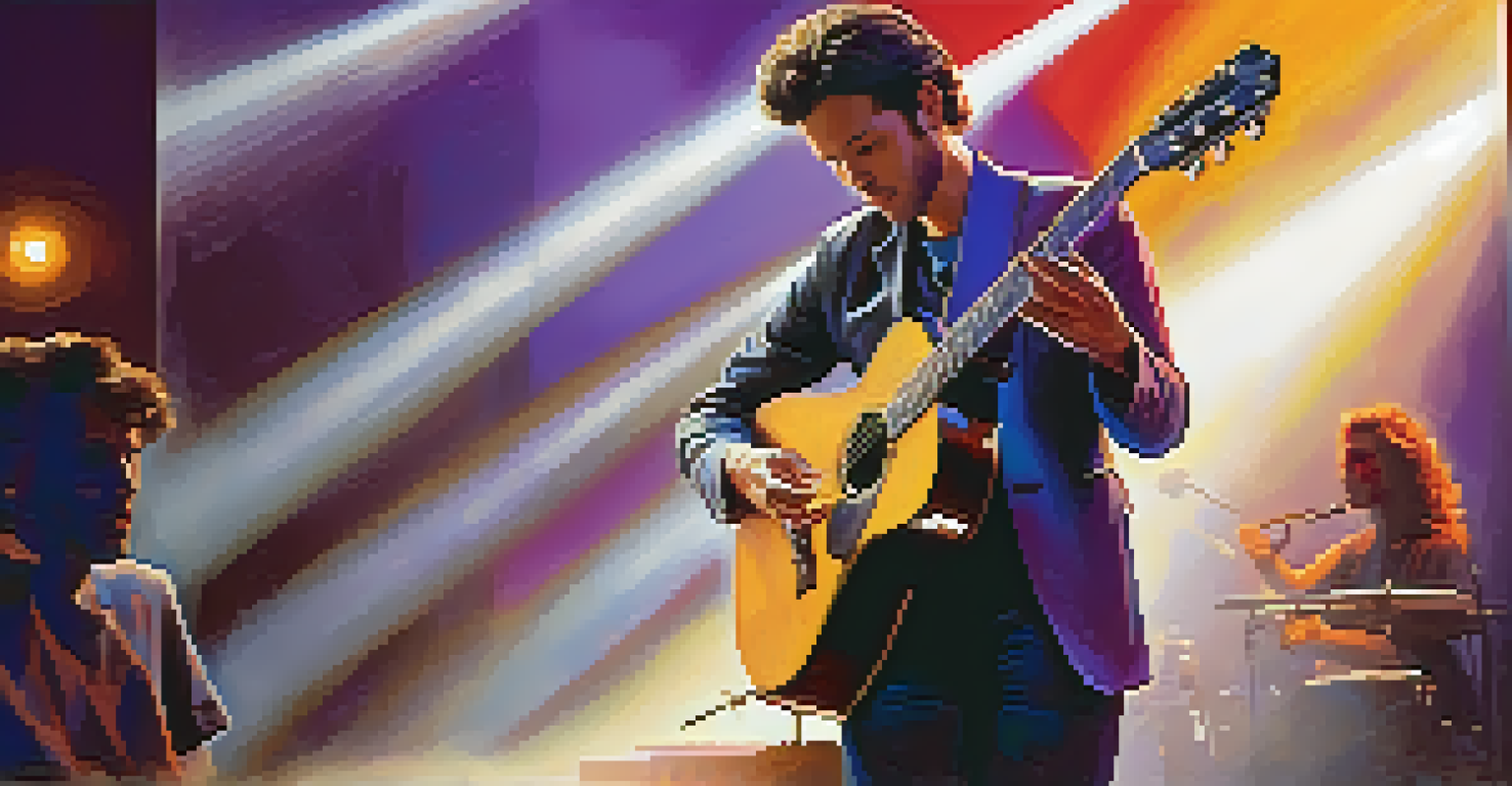The Role of Melody in Personal Storytelling with Guitar

Understanding the Power of Melody in Storytelling
Melody is more than just a series of notes; it's the emotional backbone of storytelling. When you think of your favorite songs, the melodies evoke memories and feelings that words alone often can't capture. Just like a painter uses colors to convey a mood, a musician uses melody to paint vivid stories.
Melody is the essence of music and the foundation of storytelling.
In personal storytelling, melody can set the tone, whether it's happy, sad, or reflective. For instance, a light, upbeat melody can create a sense of joy while a slower, minor melody may evoke feelings of nostalgia or sorrow. This emotional connection is what makes stories resonate with listeners.
By incorporating a well-crafted melody, you can enhance the narrative you’re sharing. The right melody serves as a backdrop that supports your words, making the story more relatable and memorable. It’s like adding a rich layer of flavor to a dish; it elevates the entire experience.
Crafting Melodies That Reflect Personal Experiences
Creating a melody that reflects your personal experiences begins with honesty. Think about the key moments in your life that shaped you: the highs, the lows, and everything in between. By tapping into these emotions, you can create a melody that feels authentic and true to your story.

For example, if you’re telling a story about overcoming challenges, consider a melody that builds in intensity. This can mirror your journey, starting softly and gradually growing as you share your triumphs. The rise and fall of the melody can echo the emotional rollercoaster of your experiences.
Melody Enhances Emotional Storytelling
Incorporating melody into storytelling creates a deeper emotional connection and makes narratives more relatable and memorable.
Experimenting with different musical scales and rhythms can also help you find the right sound. Don’t be afraid to play around until the melody feels right. Remember, the goal is to make your audience feel what you felt, and the right melody is key in achieving that connection.
The Connection Between Melody and Emotion
Melody has a unique ability to connect with human emotions on a profound level. Research shows that certain musical intervals and patterns can trigger specific feelings, making them powerful tools in storytelling. For example, a minor key often evokes sadness, while a major key can create a sense of happiness or triumph.
Music can change the world because it can change people.
This emotional aspect of melody allows you to guide your audience through the story. As you play your guitar, the shifts in melody can cue your listeners to feel joy, sorrow, tension, or relief at different points in your narrative. It’s an art form that transcends language and speaks directly to the heart.
Think of your favorite movie scores; they often amplify the emotions of the scenes. Similarly, when you use melody in personal storytelling, you’re crafting a soundscape that enhances the narrative. It’s a dance between melody and emotion that creates a memorable experience for your audience.
Using Melody to Build Tension and Release
Melody can also be an effective tool for building tension in your storytelling. Just as a suspenseful movie score keeps viewers on the edge of their seats, a well-placed melody can create anticipation in your narrative. This technique draws listeners in, making them eager to hear what comes next.
For instance, consider using a rising melody that becomes more complex as the story reaches a climax. This can mirror the escalating tension in your narrative, making the eventual resolution even more satisfying. The contrast between tension and release is essential in keeping your audience engaged.
Tension and Release Through Melody
Using melody to build tension and provide relief keeps the audience engaged and enhances the storytelling experience.
Once the tension peaks, a shift in melody can provide a sense of relief. This transition can signal a resolution or a moment of reflection, allowing your audience to breathe and absorb the story. Balancing these elements can create a powerful emotional journey that resonates deeply.
Creating Memorable Hooks with Melody
A catchy hook is crucial in making your story memorable, and melody plays a significant role in this. It’s often the part of the song or story that sticks in your listeners' minds long after they’ve heard it. A well-crafted melody can create a sense of familiarity and connection, inviting your audience to return to your story.
Think of popular songs with unforgettable hooks; they often encapsulate the essence of the song’s message. Similarly, if you can create a melodic motif that represents a key theme in your personal story, it will resonate more with your audience. This makes your narrative not just a story but an experience they can relate to.
Incorporating these melodic hooks throughout your storytelling can create a sense of cohesion. As your audience hears the melody recur, it reinforces the connections between different parts of your story, making it more impactful. This strategy can turn a simple narrative into a compelling journey that lingers in the hearts of listeners.
The Role of Improvisation in Personal Storytelling
Improvisation adds a spontaneous element to personal storytelling with guitar. It allows you to express emotions in real-time, creating a unique experience for both you and your audience. This freedom can lead to unexpected melodies that genuinely reflect your feelings as you share your story.
Imagine standing in front of an audience, and as you begin to share a particularly emotional moment, you let the melody flow naturally. This organic approach can bring authenticity to your storytelling, allowing listeners to connect with you on a deeper level. It’s as if you’re inviting them into your personal experience.
Integrating Lyrics and Melody
The synergy between melody and lyrics creates a holistic storytelling experience that resonates more deeply with listeners.
Improvisation also encourages creativity, enabling you to explore different melodic ideas without the constraints of a predetermined structure. This can lead to moments of pure magic, where the melody captures the essence of your story in ways you hadn’t planned. Embracing this spontaneity can elevate your storytelling to new heights.
Integrating Lyrics and Melody for Deeper Impact
The synergy between melody and lyrics is crucial for impactful storytelling. While melody conveys emotion, lyrics provide the narrative framework. Together, they create a holistic experience that resonates more deeply with listeners. Think of your favorite songs; the melody often carries the emotional weight of the lyrics.
When crafting your story, consider how the melody can enhance the message of your lyrics. A well-timed shift in melody can emphasize a pivotal moment in your narrative, drawing attention to key phrases. This combination allows you to express complex emotions and ideas in a way that feels both relatable and profound.

As you weave together melody and lyrics, remember to keep the flow natural. The transitions between the two should feel seamless, creating a cohesive storytelling experience. This integration will help your audience feel fully immersed in your story, making it memorable and impactful.